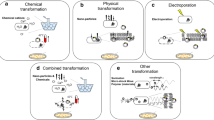Abstract
The bacterial and tissue cells can grow in batch and continuous culture. In batch culture the cells have different physiological states during incubation. The generation time changes from time to time during growth, except in the exponential phase. In continuous culture the cell growth takes place under steady-state conditions. In different steady-states the generation times reached remain constant at a certain level. This paper presents evidence of how the generation time influences the cell size, the chain formation, the multiplication of viruses, the development of competence both in transformation and transfection and the quantitative changes of lytic factor. In the experiments it is necessary to give the values of the generation times. This parameter helps the experimenters to compare the results and to avoid some errors in their conclusions.
Similar content being viewed by others
References
Braun, W.:Bacterial genetics, p. 239. W. B. Saunders Company, Philadelphia & London, 1965.
Bryson, V., Szybalski, W.:Microbial selection. Science, 116: 45, 1952.
Ecker, R. E., Schaechter, M.:Bacterial growth under conditions of limited nutrition. Ann. N. Y. Acad. Sci. 102: 549, 1963.
Herbert, D., Eisworth, R., Telling, R. C.:The continuous culture of bacteria; a theoretical and experimental study. J. gen. Microbiol. 14: 601, 1956.
Hershey, A. D., Bronfenbrenner, J.:Factors limiting bacterial growth. J. gen. Physiol. 21: 721, 1938.
Horváth, S.:A new sensitive method of the rolling drum type for influenza virus titration. Acta Microbiol. Acad. Sci. hung. 1: 481, 1954.
Horváth, S.:A quantitative semi-micro tissue culture method and its use in microbiology II. Use of the method in titrating the virus of Aujeszky disease. Acta Microbiol. Acad. Sci. hung. 6: 5, 1959.
Horváth, S.:Development of competence in cultures of Bacillus subtilis inoculated with different numbers of bacteria. J. gen. Microbiol. 48: 215, 1967.
Horváth, S.:Competence in Bacillus subtilis transformation system. J. gen. Microbiol. 51: 85, 1968a.
Horváth, S.:Lytic factor and competence in Bacillus subtilis. Acta Microbiol. Acad. Sci. hung. 15: 173, 1968b.
Horváth, S., Alföldi, L.:A new and sensitive method of phage titration on plastic trays. Acta Microbiol. Acad. Sci. hung. 1: 495, 1954.
Horváth, S., Balázs, V.:A quantitative semi-microtissue culture method and its use in microbiology I. Quantitative semi-micro tissue culture method. Acta Microbiol. Acad. Sci. hung. 5: 415, 1958.
Luria, S. E., Delbrück, M. E.:Mutation of bacteria from virus sensitivity to virus resistance. Genetics, 28: 491, 1943.
Maaløe, O., Kjeldgaard, N. O.:Control of macromolecular synthesis. W. A. Benjamin, Inc. New York, Amsterdam, 1966.
Mandell, J. D., Hershey, A. D.:A fractionating column for analysis of nucleic acids. Anal. Biochem. 1: 66, 1960.
Meyrath, J.:Interdependence of inoculum size, method of cultivation and substrate composition in amylase production and growth of Aspergillus oryzae. Zbl. Bakt. Parasit. Inf. Hyg. 119: 53, 1965.
Monod, J.:Recherches sur la croissance des cultures bacteriennes. Paris. Herman & Cie. 1942.
Monod, J.:La technique de culture continue, théorie et applications. Ann. Inst. Pasteur 79: 390, 1950.
Novick, A., Szilard, L.:Description of the chemostat. Science 112: 715, 1950.
Okubo, S., Strauss, B., Stodolsky, M.:The possible role of recombination in the infection of competent Bacillus subtilis by bacteriophage deoxyribonucleic acid. Virology 24: 552, 1964.
Powell, E. O.:Growth rate and generation time of bacteria, with special reference to continuous culture. J. gen. Microbiol. 15: 492, 1956.
Ravin, A. W.:The genetics of transformation. Adv. Genetics 10: 61, 1961.
Reilly, B. E., Spizizen, J.:Bacteriophage deoxyribonucleate infection of competent Bacillus subtilis. J. Bacteriol. 89: 782, 1965.
Romig, W. R.:Infection of Bacillus subtilis with phenol extracted bacteriophages. Virology 16: 452, 1962.
Saito, H., Miura, K. I.:Preparation of transforming deoxyribonucleic acid by phenol treatment. Biochim. biophys. Acta 72: 619, 1963.
Warren, S. C.:Sporulation in Bacillus subtilis. Biochemical changes. Biochem. J. 109: 811, 1968.
Warren, S. C.:Sporulation in Bacillus subtilis. Biochemical changes. Biochem. J. 109: 811, 1968.
Young, F. E., Spizizen, J.:Physiological and genetic factors affecting transformation of Bacillus subtilis. J. Bacteriol. 81: 823, 1961.
Young, F. E., Spizizen, J.:Biochemical aspect of competence in the Bacillus subtilis transformation system. J. biol. Chem. 238: 3126, 1963.
Author information
Authors and Affiliations
Rights and permissions
About this article
Cite this article
Horváth, S. Importance of the generation time in microbiological experiments. Folia Microbiol 15, 259–266 (1970). https://doi.org/10.1007/BF02869052
Received:
Issue Date:
DOI: https://doi.org/10.1007/BF02869052




